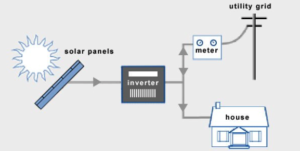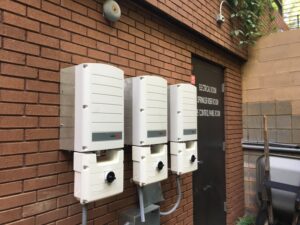2021 dawned with the completion of a new solar panel array on the roof of Raleigh’s Unitarian Universalist Fellowship, which has been a work in progress since 2019. Here is a drone’s eye view of the new system:

These 117 solar panels were installed in the fall and are now producing electricity with no greenhouse gas emissions. They are a major element in UUFR’s commitment to fight climate change and reduce our carbon footprint. It is estimated they will provide 45 percent of the power used in the Fellowship Hall, and prevent the emission of 675 metric tons of carbon dioxide over the next 25 years, the equivalent of taking 146 cars off the road for a year. They’ll also save tens of thousands of dollars on the community’s electric bill over the life of the system.
Several hundred hours have gone into researching the project’s viability, filing applications, and arranging for the installation. Now that this project is complete, UUFR’s Environmental Justice Ministry is looking forward to taking on more projects that will demonstrate a congregation-wide commitment to stop climate change, including renewing its Green Sanctuary accreditation.
For questions about UUFR’s new solar array, contact Russ Outcalt at rjoutcalt@gmail.com.
And if you would like a few more details about the solar array’s technical and financial aspects, read on:

First, let’s cover the basics of how a solar photovoltaic electricity generating system works. Solar panels are silicon-based semi-conductors and when photons (sunlight) strike them, that causes electrons to flow. These electrons are in the form of direct current, like the flow from a battery, but we need alternating current to come out of our outlets. Thus, the DC is routed to inverters that convert the DC to AC. The inverters then send the electricity to the electrical panel in Fellowship Hall for our use.

During periods when the solar panels produce more than we need, the system sends the excess electricity back out to the grid and we get credit for that from Duke Energy. Those credits reduce our electricity bill by the amount we would have paid for the electrons we give them. So this allows us to fully take advantage of all the power we produce.
Our system consists of 117 solar panels, which can each generate 320 watts of electricity when in full sun, for a maximum of 41.5 kW of system generating power. We will probably never see that level, however, as the sun is never exactly overhead and there are always some shading effects due to nearby trees and the horizon. However, our system is a respectable size and should cover almost half of the electricity needs of Fellowship Hall on an annual basis.

You may wonder why we did not place any panels on the curved metal roof that covers the Sanctuary. There are two reasons for that. First, the metal roof is a key architectural element, forming a chalice-like curve. Eventually, the fellowship plans to replace Peace Hall and a second building with a curved roof to complete the “chalice”. So aesthetically, placing solar panels there is problematic.
Practically there are problems as well. The metal roof consists of overlapping panels which expand and contract as a function of temperature. Placing panels on such an inherently unstable platform would be challenging, and we decided for all these reasons not to expand the system to the metal roof.
A final aspect of the solar array project is how we are paying for it. Since the North Carolina legislature passed House Bill 589 in 2017, non-profit organizations have new financing options for solar arrays. Third-party vendors are allowed to lease systems while claiming and reselling the tax credits, which heretofore were of no benefit to an institution such as UUFR that does not pay taxes.
Further, the bill required Duke Energy to pay rebates to customers who install solar PV systems based on their size. We worked with Eagle Solar and Light on just such an arrangement. Our system cost about $110,000 resulting in a rebate of $32,400. Eagle used our rebate to cover all upfront installation costs and we will pay a lease to Eagle of $4,100 per year for ten years. However, the reduction in our electricity bill will nearly match the lease payment, leaving us with just about $500 per year in out-of-pocket costs. At the end of the lease, we can purchase the system for about $10,000 or ask Eagle to remove it. If we purchase it, the system should last at least another fifteen years and is projected to save us about $50,000 in electricity bills over the full twenty-five years. So this agreement did not cost us any money upfront and should save us money in the long run while fighting climate change. A win-win.




